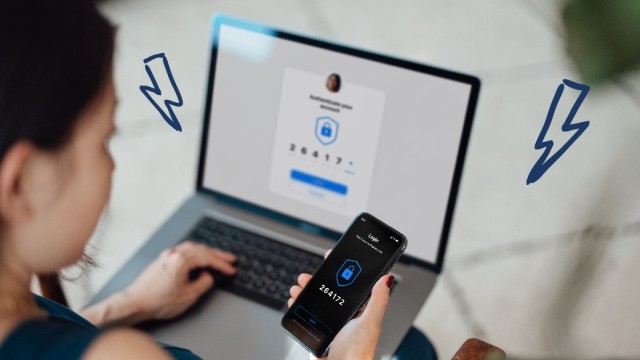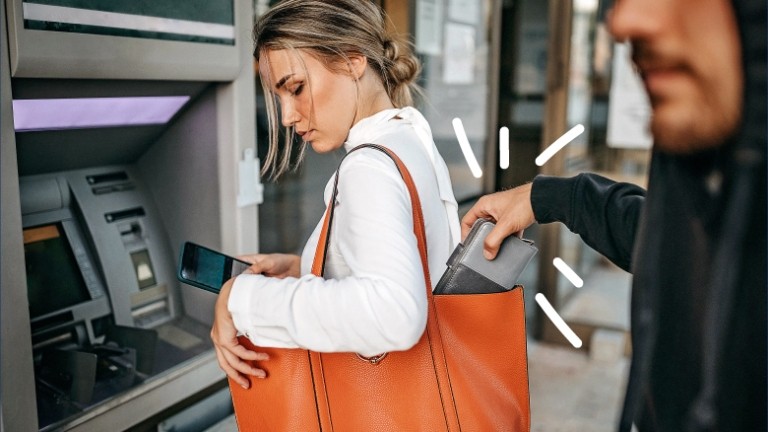Tips for safe shopping during the holiday season

With holiday shopping in full swing, it’s a good time to think about protecting yourself from identity theft. You’ll be entering your card numbers into various websites and pulling your card out at registers all over town. And while we have a variety of measures put into place to keep your accounts secure, you are the best defense against scammers and thieves.
Read about the most common types of scams here.
Fortunately, there are some simple steps that could lessen the likelihood that you become a victim.
Shopping
Santa isn’t the only one paying attention this time of year. When we use credit and debit cards, it’s an opportunity for theft. If you’re shopping locally, pay attention to those around you while at the ATM or during a transaction at a store. Watch the store clerk while they have your card and verify the amount before you sign. (Or use a card with tap-to-pay technology, like our credit and debit cards, so you don’t have to hand your card over at the register at all!)
And don’t forget to examine the charges on your credit card statement each month and call your credit card company immediately if something doesn’t look right.
Likewise, be sure to regularly check your checking and savings accounts for any suspicious activity or transactions you don’t recall making. It’s easy to check your accounts from anywhere, through MyOCCU Online & Mobile.
If you’re shopping online, use a firewall program to prevent your computer from being accessible to hackers. Enter personal and financial information on a website only when there is a “lock” icon on the browser’s status bar and look for the URL to read “https” instead of “http.”
For sites you frequent to shop or pay bills, use a strong password such as hard–to-guess combinations of uppercase and lowercase letters and numbers. Don’t use the automatic login feature and always log off when you’re finished.
Between all the holiday greetings, gifts and bills, there is a lot of mail coming and going this time of year. Keeping tabs on it is a good way to limit your risk for identity theft. Consider these tips to help keep you safe from mail fraud:
-
Request a vacation hold when you’re visiting grandma or hitting the slopes.
-
Deposit outgoing mail, particularly bills, at a collection box.
-
If you aren’t home to remove mail promptly, consider replacing your existing mailbox with one that locks.
-
Once those credit card statements have come in and been paid, shred them with a crosscut shredder. Also, take note if a bill doesn’t arrive on time and call the company immediately.
Email also requires vigilance. Phishing scams are a common way that criminals seek to obtain your personal information. Phishing is usually an email that may tell you that your account has been hacked and they need to verify personal information and direct you to click on a link to provide that information. The email may contain the organization’s logo and perhaps some personal information, such as your email address.
These scams are relatively easy to avoid if you remember one thing: A legitimate organization should never contact you to ask you to reveal personal information, by phone or by email. The only time an organization should ask for information such as your Social Security number, PIN or account number is when you have contacted them. Don’t ever download files or click on hyperlinks in emails sent by people or companies you don’t know.
New Year’s resolutions
Start the year off right by taking extra care to guard your personal information. Remember the tips above all year-round, plus keep your purse or wallet, as well as your identification and financial documents, in a safe place. For instance, memorize your Social Security number so you don’t need to carry the card around with you. Don’t have your Social Security number printed on your checks and provide it only when necessary and when you understand how your number will be used and what happens if you refuse. Photocopy both sides of your credit cards so you have all the account numbers, expiration dates and phone numbers and keep those in a safe place with the rest of your documents. It’s a good idea to check your credit rating periodically to make sure it hasn’t dropped significantly. Finally, before disposing of a computer, tablet or mobile phone, be sure to delete all personal information using a “wipe” utility program to overwrite the entire hard drive.
How do you know someone has stolen your identity? Obviously, if you see withdrawals from your account that you can’t explain or if debt collectors call you about debts that are not yours, those are some big clues. Some identifiers are more subtle but could indicate big problems — if bills stop coming, for example, or medical providers bill you for services you didn’t use, or the IRS notifies you that more than one tax return was filed in your name.
If these or other clues tip you off that you have become a victim of identity theft, the Federal Trade Commission has an online resource, identitytheft.gov, that will walk you through the steps to begin the recovery process.


